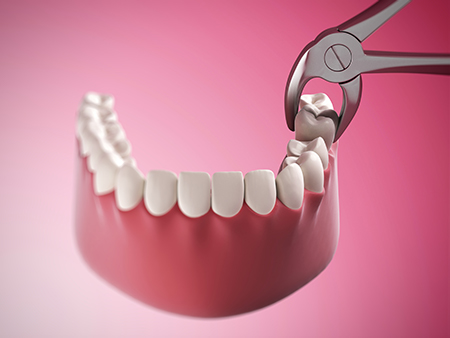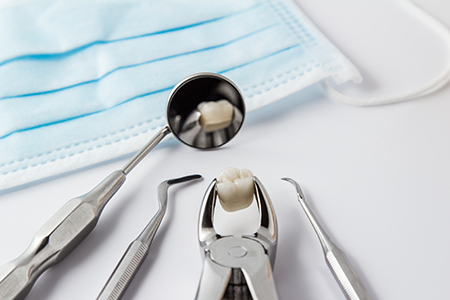
At the office of Value Dental Center, we begin every treatment by asking the same question: can this tooth be saved? Our team prioritizes preservation whenever possible, but we also recognize that removing a tooth is sometimes the most responsible choice to protect a patient’s long-term oral health. We approach extractions with the same attention to detail and compassion that guides all of our care, helping patients feel informed and comfortable every step of the way.
An extraction may be recommended for reasons ranging from developmental issues to advanced disease. Removing a tooth can relieve pain, stop the spread of infection, and prevent damage to neighboring teeth and bone. We explain the rationale clearly, review alternatives when they exist, and tailor the plan to each patient’s medical history and personal needs.
Understanding why an extraction has become necessary helps patients make confident decisions about their oral health. Below are the most common scenarios that lead our dentists to recommend removing a tooth; each entry explains what’s happening and why extraction may be the best option for a successful outcome.
Delayed or problematic baby tooth loss
Sometimes a primary (baby) tooth remains firmly anchored after the permanent tooth beneath it starts to develop. This can happen when the baby tooth’s roots fail to resorb or when the tooth becomes fused to the jawbone (ankylosed). Left unaddressed, an over-retained baby tooth can interfere with normal eruption and alignment of the permanent teeth, so timely extraction is occasionally advised to support proper development.
Extensive decay that leaves the tooth non-restorable
Tooth decay begins on the enamel and, if untreated, can progress into deeper layers of the tooth. When structural damage is so severe that a stable restoration is not feasible, extraction prevents ongoing infection and pain. Removing a hopeless tooth also allows us to plan for an appropriate replacement that preserves function and appearance.
Irreparable fractures or severe structural damage
Teeth that are deeply cracked or fractured sometimes cannot be rebuilt safely. If the break extends into the root or there is insufficient healthy tooth structure remaining, extraction may be the most predictable way to eliminate pain and avoid repeated procedures that would compromise long-term results.
Advanced periodontal (gum) disease
When periodontal disease has destroyed the tissues and bone that support a tooth, the tooth may become loose or painful. In advanced cases, extraction can halt progression, reduce infection, and improve overall oral health. Removing severely compromised teeth can also make future restorative care more successful.
Wisdom teeth that are impacted or causing problems
Third molars frequently lack room to erupt properly. Impacted or partially erupted wisdom teeth can trap food, encourage decay, and impinge on adjacent teeth. For many patients, removing problematic wisdom teeth prevents future complications and protects the alignment and health of neighboring teeth.
Extractions as part of orthodontic or treatment planning
Occasionally, removing one or more teeth is the most predictable way to correct severe crowding and create space for proper alignment. As part of a comprehensive orthodontic plan, selective extractions can simplify treatment and improve long-term function and esthetics.

Before any extraction, our team completes a thorough clinical assessment and reviews your medical history to identify any factors that might influence care. We ask about current medications, previous surgeries, and systemic conditions because these details guide safe treatment planning. If needed, we coordinate with your physician to ensure any medical risks are addressed first.
Imaging is an important part of this evaluation. We use digital radiographs and other diagnostic tools as indicated to examine root shape, bone level, and proximity to vital structures. These images help us decide whether a tooth can be removed with simple forceps or will require a surgical approach.
We also talk with patients about comfort options. Local anesthesia reliably numbs the area for virtually all extractions, and for those who experience anxiety or require more complex care, we discuss sedation options to make the experience as comfortable as possible.
When a tooth’s crown is fully visible and the root is straightforward, a simple extraction is often all that’s needed. After numbing the area, the dentist gently loosens the tooth with specialized instruments and uses forceps to remove it. The technique minimizes trauma to the surrounding tissues and typically allows for an uncomplicated recovery.
Patients who have routine simple extractions usually go home the same day with clear aftercare instructions and scheduled follow-up if necessary. We emphasize pain management, infection prevention, and steps to promote healing so patients know what to expect once they leave the office.
Teeth that are broken below the gumline, fused to the jawbone, or impacted often require a surgical approach. This may involve a small incision, the removal of a bit of bone, and careful sectioning of the tooth so it can be removed safely. In complex cases we may refer to or collaborate with an oral and maxillofacial surgeon.
Surgical extractions are performed under local anesthesia and, where appropriate, additional sedation. We provide detailed pre-operative instructions and discuss recovery expectations so patients feel prepared and supported throughout the process.

Healing after an extraction varies by patient and procedure complexity, but most people experience predictable, manageable symptoms that improve quickly with the right care. We give tailored post-operative instructions to promote clot formation, reduce swelling, manage discomfort, and lower the risk of complications like infection or dry socket.
It’s important to follow all post-op directions and to take any prescribed antibiotics or pain medications exactly as instructed. If you have allergies or are taking other medications, let us know so we can tailor your prescriptions safely. Staying well hydrated and resting on the day of the procedure also supports recovery.
We schedule follow-up appointments when indicated — for example, when stitches are placed or if additional monitoring is appropriate. These visits let us confirm that healing is on track and address any questions or concerns that arise after the extraction.
Control bleeding with gauze
A gauze pad will be placed at the extraction site; bite gently to maintain consistent pressure. Change the gauze as instructed and replace it if bleeding persists. Minor oozing over 24 hours is common, but contact us if you experience heavy, ongoing bleeding.
Protect numb tissues
Until the local anesthetic wears off, avoid chewing or touching the area to prevent accidental bites to the lips, cheeks, or tongue.
Take medications as directed
Antibiotics:
If prescribed, complete the course to reduce the risk of infection.
Pain control:
Start pain medication on the schedule recommended by your clinician. Over-the-counter non-aspirin analgesics are often sufficient; use prescription analgesics only as directed.
Avoid disturbing the clot
Do not rinse vigorously, spit forcefully, use a straw, or suck on hard candies for several days. These actions can dislodge the clot and delay healing.
Manage swelling with ice
Apply an ice pack to the cheek in 10–15 minute intervals during the first 24 hours to reduce swelling and discomfort.
Don’t smoke
Tobacco use interferes with clot formation and healing. Avoid smoking for at least the first week after an extraction to support proper recovery.
Choose soft foods
Stick to cool or lukewarm soft foods for the first two days. Avoid hot, spicy, crunchy, or carbonated items until the site begins to heal.
Maintain gentle oral hygiene
Brush carefully and avoid the extraction area for a short time. After 24–48 hours, gentle rinses with lukewarm saltwater can help keep the mouth clean — do not rinse forcefully.
Keep your follow-up appointment
If sutures were placed or if your extraction was complex, returning for a follow-up visit allows us to confirm appropriate healing and remove stitches if needed.
If bleeding persists, swelling increases, you develop a persistent bad taste or odor, or you experience unusual or worsening pain, contact our office for guidance.

After a tooth is removed, replacing it becomes an important part of restoring chewing ability, maintaining the position of adjacent teeth, and preserving bone. We discuss replacement options early so patients can make informed choices that match their health goals and lifestyle. When appropriate, replacement can be coordinated soon after extraction or planned as a staged process.
Options commonly include dentures, fixed bridges, and dental implants. Each approach has advantages: dentures restore multiple missing teeth, bridges provide a fixed solution for adjacent spaces, and implants offer a long-term option that preserves bone and feels most like a natural tooth.
At Value Dental Center, we help patients weigh the clinical and lifestyle factors that influence which replacement is best. Our recommendations consider oral health, the condition of neighboring teeth, bone quantity, and a patient’s personal preferences so the final plan supports both function and appearance.
Many extractions are preventable with consistent care and early treatment. Routine dental exams, professional cleanings, and prompt attention to cavities or gum disease reduce the likelihood that a tooth will reach the point of needing removal. We emphasize prevention as the most effective long-term strategy for protecting your smile.
Good home care — including twice-daily brushing with fluoride toothpaste, daily flossing, and limiting sugary snacks — makes a measurable difference. For patients with specific risks, we may recommend sealants, fluoride applications, or more frequent professional visits to monitor vulnerable areas closely.
When orthodontic concerns, wisdom tooth development, or other structural issues are identified early, proactive planning can avoid future complications. Working with our team to address small problems before they escalate helps preserve your natural teeth and reduces the need for extractions later on.
In summary, extractions are sometimes the healthiest option to relieve pain, stop infection, or prepare the mouth for predictable restorative treatment. We take a thoughtful, individualized approach to every case—prioritizing safety, comfort, and long-term results. If you’d like to learn more about what to expect from an extraction or discuss tooth replacement options, please contact us for more information.
The most common reasons for tooth loss include advanced periodontal disease, extensive tooth decay, and facial trauma. According to statistics, gum disease is responsible for close to 70% of tooth loss in adults. Although less frequent than the preceding three reasons, it should also be noted that specific diseases, drugs, smoking, and poor nutrition contribute to the risk of tooth loss.
The Centers for Disease Control and Prevention report that in the United States, an average of 12 teeth (including the wisdom teeth) are lost by the age of 50. Also, 26% of adults between 65 and 74 years of age have lost all their teeth.
Every patient and every situation is different. However, when a tooth and the surrounding tissues are numbed with a local anesthetic, you should only expect to feel a bit of pressure, but no pain as the tooth is being loosened from the surrounding tissues and extracted. For patients who are apprehensive and for some surgical extractions, our office will discuss our options in dental sedation to provide further relaxation and reduce any sense of discomfort.
While it's normal to feel some tenderness and swelling following an extraction, the degree of these sensations can vary. It mostly depends on the complexity of the extraction and the body's response to the procedure. We'll recommend or prescribe the appropriate pain medication to help ensure your comfort and give you specific instructions for maximum effectiveness and safety.
Typically, the recovery period following a simple extraction is shorter than a surgical extraction. However, a patient's overall health, habits, the size and location of the tooth, and other variables can influence recovery and healing. To speed up the recovery and avoid any complications, patients must follow the given at-home instructions diligently. We'll carefully review what to expect following your procedure and go over your post-op instructions.
Smoking interferes with blood clot formation, which is an essential first step in the healing process. Blood clot formation not only provides a protective layer to cover the underlying exposed bone and nerve endings, but it also supports the growth of new tissue. Cigarette smoke also contains chemical toxins that can disrupt the healing process and lead to problems such as continued inflammation, infection, or dry socket.
In a very small percentage of cases, a condition known as dry socket can develop in the aftermath of a dental extraction. This painful condition can arise when the blood clot in the extraction site doesn't form properly or gets dislodged. With dry socket, you may experience throbbing pain and symptoms such as bad breath and an unpleasant taste in your mouth. As skilled providers of care, our office will provide immediate treatment to alleviate your discomfort and promote healing.
The last teeth in your mouth to develop, wisdom teeth often do not have enough room to fully erupt or may be positioned in the wrong direction. These issues can affect your dental health as well as overall wellbeing. While some individuals never develop all their wisdom teeth, and a few have sufficient space for them, there are many people with partially or fully impacted third molars. Our office will monitor the development, position, and health of your wisdom teeth and will advise you if and when extractions are indicated.
After a tooth is removed, bone-grafting material is sometimes placed in the socket to promote healing and encourage new bone development. This procedure is often performed to support the eventual and successful placement of a dental implant.
At the office of Value Dental Center, we strive to make dental care affordable and accessible. Depending on the type or complexity of the extraction and other variables, the cost of the procedure can vary. Based on our diagnostic findings, our office will inform you of the healthiest choices in care, explain the fees, discuss insurance coverage, and explain your payment options.
Many dental plans offer some level of coverage for tooth extractions. We'll advise you if your plan covers the full cost of the procedure and if there is any out-of-pocket expense. Our business office will work with you to maximize your insurance benefits as much as possible while helping you minimize any out-of-pocket expenses.
Your dentist may recommend an extraction when removing a tooth is the safest way to protect your oral health. Common reasons include a tooth that is too badly decayed to restore, a severe fracture that compromises the root, advanced periodontal disease that has destroyed supporting tissues, problematic wisdom teeth, or an overretained baby tooth that interferes with alignment. Extractions are also sometimes part of orthodontic planning when removing select permanent teeth improves overall bite and function.
Recommending an extraction follows a careful evaluation that weighs the benefits of saving the tooth versus the risks of keeping it. When a tooth cannot be predictably restored or poses a risk to adjacent teeth or the jawbone, removal becomes the most responsible course of care. Your dentist will discuss alternatives, expected outcomes, and any follow-up treatment needed to restore form and function.
The decision between a simple and a surgical extraction depends on the tooth's position, root anatomy, and the degree of damage. A simple extraction is performed on a tooth that is fully visible in the mouth with straightforward root anatomy, while a surgical extraction is chosen for broken, ankylosed, impacted, or otherwise difficult-to-access teeth. Digital radiographs and a clinical exam are used to assess root shape, proximity to anatomical structures, and bone coverage.
If complexity is anticipated, your dentist may plan for surgical techniques such as a small incision, bone removal, or sectioning the tooth for safer removal. In some cases a referral to an oral and maxillofacial surgeon is recommended so specialized surgical skills and sedation options can be provided. The goal is always to remove the tooth while minimizing trauma and protecting surrounding tissues.
Before an extraction you should provide a complete medical and dental history, including any medications, supplements, and recent or chronic health conditions. Certain conditions and medications can affect bleeding, healing, or infection risk, so your dentist needs to know about blood thinners, heart conditions, diabetes, immune disorders, and any history of joint replacements or prosthetic heart valves. It is also important to mention allergies, prior reactions to anesthesia, and pregnancy.
Based on your history, your dentist may request medical clearance, adjust medications in consultation with your physician, or recommend preoperative antibiotics for select situations. Clear communication helps your dental team plan appropriate precautions and choose the safest anesthesia or sedation approach to keep you comfortable throughout the procedure.
A simple extraction is typically performed under local anesthesia after the tooth and surrounding tissues are thoroughly numbed. The dentist will loosen the tooth by gently expanding the socket and detaching periodontal fibers, then remove the tooth using extraction forceps with controlled motion to limit trauma to the bone. The procedure is generally brief and well tolerated, and additional sedation can be discussed for anxious patients.
After removal, the socket is carefully inspected and gauze is applied to help control bleeding while a clot forms. Your dentist will review post-operative instructions such as activity limitations, medication use, and oral hygiene precautions to promote healing and reduce the risk of complications. A follow-up visit may be scheduled when indicated to monitor recovery or remove sutures.
Surgical extractions are indicated for teeth that are broken at or below the gumline, impacted wisdom teeth, or teeth with complex root anatomy that cannot be removed with forceps alone. The procedure commonly involves a small incision in the gum, precise removal of a small amount of bone if necessary, and sometimes sectioning the tooth into parts to allow safe removal with minimal force. Local anesthesia is used and sedation options are available for patient comfort.
Your dentist may refer you to an oral and maxillofacial surgeon when the extraction is complex, when you have medical conditions that require specialized management, or when advanced sedation is preferred. Surgeons bring surgical expertise and expanded anesthesia options for cases that demand greater technical control. Referrals are made to ensure the safest outcome and the most predictable healing.
Immediately after an extraction you can expect a short period of oozing from the socket that typically subsides as a blood clot forms, and local anesthesia may leave the area numb for several hours. Your clinician will provide gauze to apply gentle pressure, instructions for managing discomfort with recommended medications, and guidance on activity and diet for the first 24 to 48 hours. Mild swelling and bruising may occur and can be managed with intermittent ice application.
It is important to avoid disturbing the clot by not rinsing vigorously, spitting, using a straw, or smoking during the early healing period. Keeping activity light and following the post-operative directions provided by your dental team will support clot stability and reduce the risk of complications. Contact the office if bleeding is heavy, pain escalates despite medications, or you develop fever or other concerning symptoms.
Good post-operative care supports healing and helps prevent issues like dry socket or infection. Maintain gentle oral hygiene by brushing nearby teeth carefully and using a mild saltwater rinse after the first 24 hours to keep the area clean, taking care not to swish forcefully. Follow your dentist's guidance about prescribed antibiotics or pain medications and complete any antibiotic course if given.
Stick to a soft-food diet for the first few days, stay hydrated, and avoid smoking or using tobacco products because they impair clot formation and delay healing. Attend any scheduled follow-up appointments so your dental team can monitor recovery and remove sutures if needed. If you have questions about specific foods, oral care products, or activity restrictions, check with your provider for tailored advice.
While most extractions heal without problems, certain signs warrant prompt contact with your dental team. Seek care if you experience heavy or prolonged bleeding, increasing or severe pain that does not respond to medication, persistent swelling that worsens after three days, a fever, or a bad taste or odor that might indicate infection. Another common issue is dry socket, which presents as intense localized pain beginning a few days after the procedure and may require additional treatment.
Timely communication allows your dentist to evaluate the situation, prescribe medications if infection is suspected, or provide interventions to manage dry socket and other complications. Do not hesitate to call the office if you have concerns about healing, new symptoms, or questions about your recovery timeline so that appropriate care can be arranged.
Replacing a missing tooth is often recommended to restore chewing function, prevent shifting of adjacent teeth, and maintain jawbone health when appropriate. The timing for replacement depends on the extraction reason, the condition of adjacent teeth, and your overall treatment plan; sometimes an immediate temporary replacement is possible, while other situations require a healing period before restorative steps begin. Your dentist will discuss the optimal timing and sequence based on your needs.
Common replacement options include removable dentures, fixed dental bridges, and dental implants, each with benefits and considerations related to durability, maintenance, and how they affect surrounding structures. Dental implants are widely regarded for their ability to preserve bone and provide a stable, long-term solution, while bridges and dentures offer predictable restorative alternatives when implants are not appropriate. Your dentist will review the clinical factors and recommend the best option to restore comfort, function, and appearance.
At the office of Value Dental Center we emphasize gentle, evidence-based care and clear communication throughout the extraction process. Our team performs thorough preoperative assessments, uses digital radiography to evaluate root and bone anatomy, and discusses anesthesia and sedation options to keep patients comfortable. We tailor each treatment plan to minimize trauma and support predictable healing.
Following the procedure, our clinicians provide detailed post-operative instructions and monitor recovery to reduce the risk of complications and to coordinate any necessary restorative care. When advanced surgical expertise or sedation is required, we collaborate with specialists to ensure safe, comprehensive care aligned with your oral health goals.
Quick Links